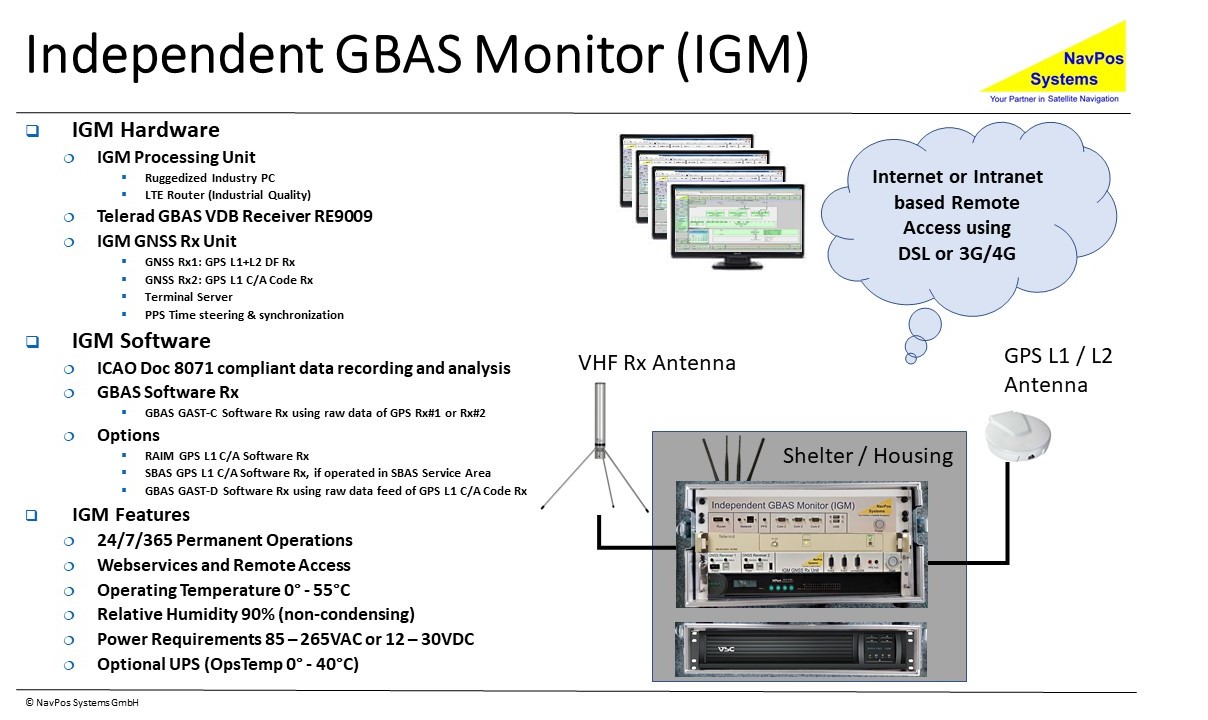
IGM Objectives
■ The main IGM objective is the operational validation of GBAS ground subsystems at airports because airport environments and GBAS Sites are different.
■ After the GBAS operational validation phase it is recommended to continue the independent GBAS monitoring due to the fact that the environmental conditions may change over time e.g. due to natural phenomena like the 11-years sun spot cycle and the varying impact of the ionosphere or unintentional interference.
■ The IGM was specified by the German air navigation service provider Deutsche Flugsicherung GmbH (DFS). It comprises a stand-alone GBAS monitoring and evaluation system which was designed for GBAS ground station performance monitoring, data recording, performance analysis and validation. The IGM itself successfully passed all DFS requirements in several factory and site acceptance tests.
■ With the 3rd IGM generation, state-of-the-art GPS receivers and additional features and sensors were added due to the increasing threats of interference, jamming and spoofing. A special highlight is a new avionics grade receiver which now feeds the GBAS Software Rx.
IGM Features
■ The IGM system in its standard configuration includes 2 GPS receivers.
• One GPS receiver is a high performance multi-frequency GNSS receiver which is used for the monitoring of the GPS Signal-In-Space to determine the GNSS error components e.g. signal propagation errors of ionosphere, troposphere and multipath.
• The GBAS VDB SIS is received using a Telerad RE9009 VDB receiver to monitor the VBD SIS in real time. This VDB Rx model is used by several GBAS ground station manufacturers.
• The second GPS receiver is a GPS L1 C/A Rx to feed the GBAS Software Rx. This Rx provides all necessary raw data to calculate GBAS PVT and xPL likewise a GBAS Rx considering all functional and algorithmic specifications as requested in the GBAS standards. Cross-comparisons of the GBAS Software Rx with certified GBAS receivers were done to validate its correctness and validity.
• Optionally, the second GPS receiver is an avionics grade GPS L1 C/A Rx to feed the GBAS Software Rx. NavPos has an exclusive Cooperation Agreement with a manufacturer of an FAA Type Approved and Aviation Certified GPS L1 C/A receiver. This Rx was modified to provide all necessary raw data to calculate GBAS PVT and xPL likewise a GBAS Rx considering all functional and algorithmic specifications as requested in the GBAS standards.
■ IGM remote access and a webservices based GUI.
■ IGM long term data recording and historical data analysis .
■ Interference Monitoring.
• Interference Detection.
• Continuous ICAO Interference Mask RF Spectrum Monitoring using a Spectrum Analyzer (Option).
■ The integration of an aviation certified GBAS receiver can be offered as an Option.
Applications
■ In 2012, Honeywell performed the GLS CAT-I precision approach certification at Bremen Airport in Germany. During this period, the IGM system was used for independent monitoring and performance evaluation of the Honeywell GBAS system.
■ Operational IGMs in Germany.
• As third-party monitoring stations, two IGM monitoring systems are permanently used at Frankfurt Airport to perform real-time monitoring of GBAS base stations.
• A further unit is currently used as part of the operational validation of a GBAS upgrade at Bremen Airport in Germany.
• NavPos also supports the German Armed Forces at 2 airbases and deployed IGM like Monitors with additional jamming & spoofing detection features.